Clearwing moth borers comprise one of the most damaging groups of insect pests that attack shade trees and shrubs. Controls must be accurately timed, since larvae tunnel under the bark most of the year, where they are unreachable by most insecticides. Artificial pheromones of many of the clearwing moths found in the landscape are available. These pheromones are a synthetic of the sex attractant emitted by many insects & are commercially available and recommended for the IPM manager.
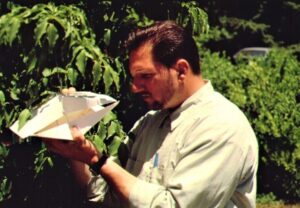
Plant manager viewing contents of clearwing moths captured in pheromone-baited wing-trap. (Photo Credit: Steven K. Rettke, Rutgers Coop. Ext.)

This green ash tree is showing severe symptoms from banded ash clearwing moths. Too late for pheromone traps to be of value. (Photo Credit: Steven K. Rettke, Rutgers Coop. Ext.)
Adult male clearwing moths are attracted to the pheromone-baited sticky trap that helps determine: 1) if the borers are present in an area; and 2) when to apply insecticide sprays. Pheromone traps enable landscape managers to accurately determine when the first emergence of the egg laying borers are expected so that insecticides can be timed & applied effectively to susceptible tree/shrub hosts. Spraying the bark of the tree to be protected with a long residual insecticide (i.e., such as pyrethroids) should effectively kill the young borer larvae as they hatch from eggs & attempt to tunnel into the stems or branches.
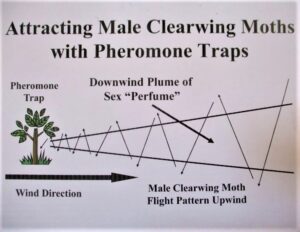
Hypothesized flight path of an adult male clearwing moth towards the pheromone trap. (Diagram: Steven K. Rettke, Rutgers Coop. Ext.)
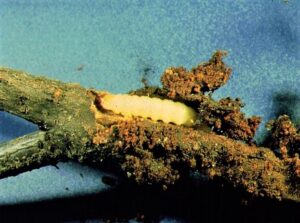
Dug out from tunnel of branch, this mature peach tree borer larva contains 5 pairs of prolegs & therefore is a moth & not a beetle borer. (Photo Credit: Dave Shetlar, Ohio State Coop. Ext.)
Many landscapers today are at least familiar with pheromone traps, even though most have never attempted to use them. Pheromone traps are commonly used in the landscape to detect the presence of adult clearwing male moths but are not used directly for controls. The traps are valuable tools to determine the right insecticide timing. Before installing clearwing moth pheromone traps, it is important to confirm that the borers infesting affected trees/shrubs are moth larvae. Most landscape wood boring larvae are either moths or beetles. The easiest way to distinguish between the larvae of clearwing moths or beetle borers is to inspect larvae for the presence of short pairs of prolegs along the abdominal region. Beetle borers do not have prolegs, whereas clearwing moths may have as many as five pairs.
Too often those who do attempt to use these traps become frustrated¸ because they are unable to identify with certainty the numerous clearwing species that are typically caught in traps (i.e., six of the more important clearwings include, 1-lilac borer, 2-rhododendron borer, 3-peach tree borer, 4-lesser peach tree borer, 5-dogwood borer, and 6-banded ash borer). In many landscapes, the peach tree borer is often the most common clearwing moth in the landscape, and is found attacking flowering cherry, peach, and other Prunus species.
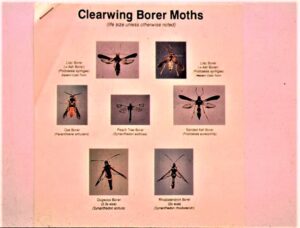
Photograph images supplied from pheromone trap distributors helps to identify clearwing moth species.
To compound the problem, many of the clearwings mentioned above are in the same genus and produce similar pheromones. Therefore, even though lures are often marketed for specific target borer species, they capture several species. Sometimes there may be more non-target borers caught within the trap than the specific borer species being targeted.
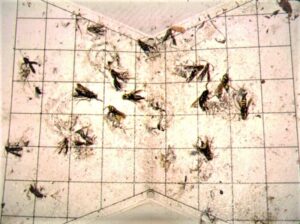
Lilac borers & Oak borers captured during May on pheromone wing-trap. (Photo Credit: Steven K. Rettke, Rutgers Coop. Ext.)
This article’s purpose is to demystify the use of pheromone traps when attempting to attract and identify clearwing moth borers present in the landscape. The casual observation of captured moths at the bottom of sticky traps will show “similar” looking insects that are often mangled and distorted. However, the challenge of identifying individual species becomes surprisingly easy to overcome when other known information about each moth species is considered. The six most important landscape clearwing borers are caught in the traps in a mostly orderly sequence. By learning the relative emergence times of the half dozen or so clearwings, the identification process is simplified.
Clearwing Moth Species Identification:
The clearwing moth adults of this family of insects resemble wasps in both appearance and action. Since the clearwing moths are daytime flyers, they have evolved to mimic wasps to reduce being preyed upon. Adult females of most of the clearwing species are attracted to bark wounds and scars to lay eggs. A notable exception is the banded ash clearwing, which will also lay eggs on healthy ash trees.
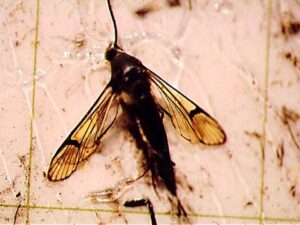
Clearwing moth adults are day-time flyers & resemble wasps to help avoid predators. (Photo Credit: Steven K. Rettke, Rutgers Coop. Ext.)
Yellow or orange bands are often present around the abdomen of some species of clearwing adults. The number of bands (usually two or more), their width and location are helpful aids with identification. The wings of all clearwings are at least partially transparent with numerous dark markings along and between the wing veins.
The first moths to appear in the traps in the spring are the lilac borers. Of all the clearwings that are likely to be attracted and caught in pheromone traps, this moth is the least distinctive and colorful. Lilac borers are about 1 inch in length, with a robust body that resembles the paper wasp. They have a drab black and brown coloration and have forewings that are more opaque than most of the other clearwing species. When using general-purpose clearwing lures, the lilac borer is often the most common moth captured earlier in the season.
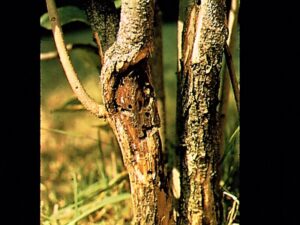
Most clearwing moth wood borers require bark wounds to enter into stems. Example of lilac stem wounds & resulting lilac borer emergence holes. (Photo Credit: Deborah Smith-Fiola, former Rutgers Ag. Agent)
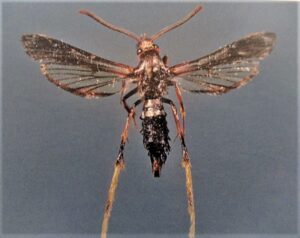
Lilac borer clearwing moth male adult. Very similar in appearance to the Banded Ash clearwing moth. Both have forewings that are mostly opaque. (Photo Credit: Michigan State Coop. Ext.)
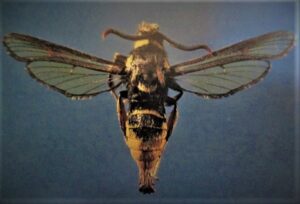
Oak Borer clearwing moth male adult also appears earlier in the spring. The striking yellow coloration of the abdomen is easy to distinguish between the other clearwing species. (Photo Credit: Michigan State Coop. Ext.)
Another of the earliest appearing moths caught in the spring is the oak borer. Although not considered a major pest in the landscape, the 1+ inch adult males of these moths have a remarkably close appearance to that of the yellow jacket wasp. The prominent yellow markings make this species dissimilar to other clearwings, and therefore, identification is easy to determine.
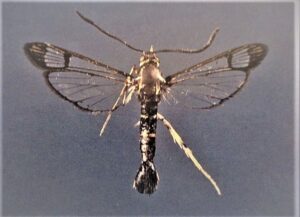
The Dogwood clearwing moth male adult will have 2-yellow colored bands encircling the abdomen. The Rhododendron Borer clearwing moth (not pictured) may be slightly larger, but has 3-yellow colored bands encircling the abdomen. Both are only 1/2 inch in size. (Photo Credit: Michigan State Coop. Ext.)
Rhododendron borers are typically the next moths to be captured in late spring (May-June). The rhododendron borers are exceptionally easy to distinguish because they are significantly smaller at half the size of most of the other species. The dogwood borer moth also appear in late spring (May-June) & is even smaller in size. Up until about 15 years ago, this clearwing species had a history of unreliable trapping in the Northeast. Today the dogwood borer pheromone has been refined & more reliable attraction occurs. Both of these smaller moths have two pairs of wings that contain few scales & are mostly clear in appearance. Counting the number of yellow-colored bands around the abdomen will help to differentiate between these two similar looking adults. The rhododendron borer has three yellow bands encircling the abdomen, whereas the dogwood borer has only two.
Peach tree borer moths will initially appear in the traps a few weeks after the rhododendron borers (June-August). Although their peak numbers will have declined, it should be noted that the lilac borer adults continue to be caught after these other species begin to emerge. The peachtree borer is about the same length as the lilac borer, but the former is slenderer in the body. Distinguishing between these two species should not be a problem, because of the striking difference of the mostly clear wings of the peachtree borer compared to the more opaque wings of the lilac borer.
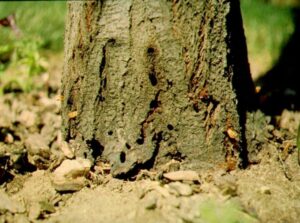
Peach tree borer emergence holes & pupal skins at base of Prunus trunk occur during the mid-weeks of summer. (Photo Credit: Dave Shetlar, Ohio State Coop. Ext.)
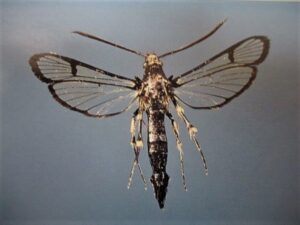
Peach tree borer adult male clearwing moth. Typically the most common species caught in the mid-summer. (Photo Credit: Michigan State Coop. Ext.)
Another clearwing moth species important to landscapers is the lesser peach tree borer. The lures required to attract this species often have the most narrow or specific activity. The chemical compound or synthetically produced pheromone is unique compared to the lures used to attract the other previously mentioned clearwing moths. Additionally, the lesser peachtree borers are known to have two distinct generations of male flight periods (June-July & August-September). Since the peach tree and lesser peach tree borers are similar in appearance and have mostly overlapping flight periods, they are the most difficult clearwings to distinguish from each other. The best way to tell them apart is to examine the head region under magnification. If the area between the eyes has a whitish coloration, then it is the lesser peach tree borer.
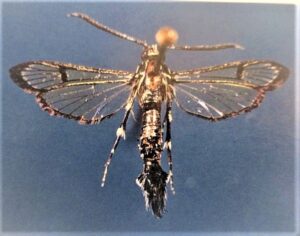
Lesser Peach Tree Borer clearwing adult male moth. Appearance closely resembles the Peach Tree Borer clearwing moth. The pheromone lure to attract this species is more specific. (Photo Credit: Michigan State Coop. Ext.)
Remember, even if the lure specifically does not state it attracts lesser peach tree borers, distinguishing between these two closely appearing species should still not be a problem, since the other lures will be less attractive to the lesser peach tree borer species. Although the host trees of both species are the same (mostly peach, cherry, plum), the location of the treatment is important. The peach tree borers lay eggs mostly from ground-level to the lower scaffold branches, while the lesser peachtree borers lay eggs at the lower scaffold branches and higher up the trunk. Therefore, the areas of the trees to focus protective insecticide sprays need to be taken into account.
The banded ash borers are the last important clearwing borer species to become active in the urban landscape during the season. Except for a single narrow yellow band across the abdomen, this species is similar looking to the lilac borer moth. However, the banded ash clearwing could never be confused with the lilac clearwing because their adult flight periods are at completely contrasting times of the year. The banded ash clearwing has one of the latest flight periods of the season, usually occurring during September & as late as October. The adult lilac borer, as stated previously, is active primarily in May and June.
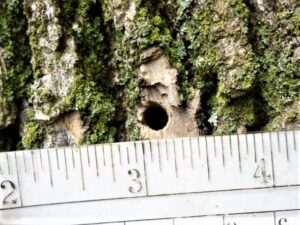
Banded Ash Borer larva maintains an opening to the outside of woody stem. All clearwing moth larvae species will maintain an exit hole to clean-out the accumulation of frass & sawdust in their larval tunnels. (Photo Credit: Steven K. Rettke, Rutgers Coop. Ext.)
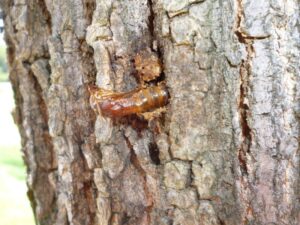
Banded Ash Borer clearwing moth pupation skin & adult moth emergence in September. (Photo Credit: Steven K. Rettke, Rutgers Coop. Ext.)
Additional information on clearwing borers including color photographs of the species mentioned in this article as well as many others, and information on host plants, flight periods, distribution, and identification can be found in the following publications:
(Reference: Taft, W.H. and J.W. Snow (1991). A Guide to the Clearwing Borers (Sesiidae) of the North Central United States. (North Central Regional Publication No. 394).
(Reference: Karl Valley, “Identifying Clearwing Borers in Pheromone Traps,” Integrated Pest Management; Commonwealth of Pennsylvania Department of Agriculture, 1997)
(Reference: Syllabus of the 1997 Advanced Landscape IPM Short Course, Volume II; Michael J. Raupp, PhD., Dept. of Entomology, Univ. of Maryland)

